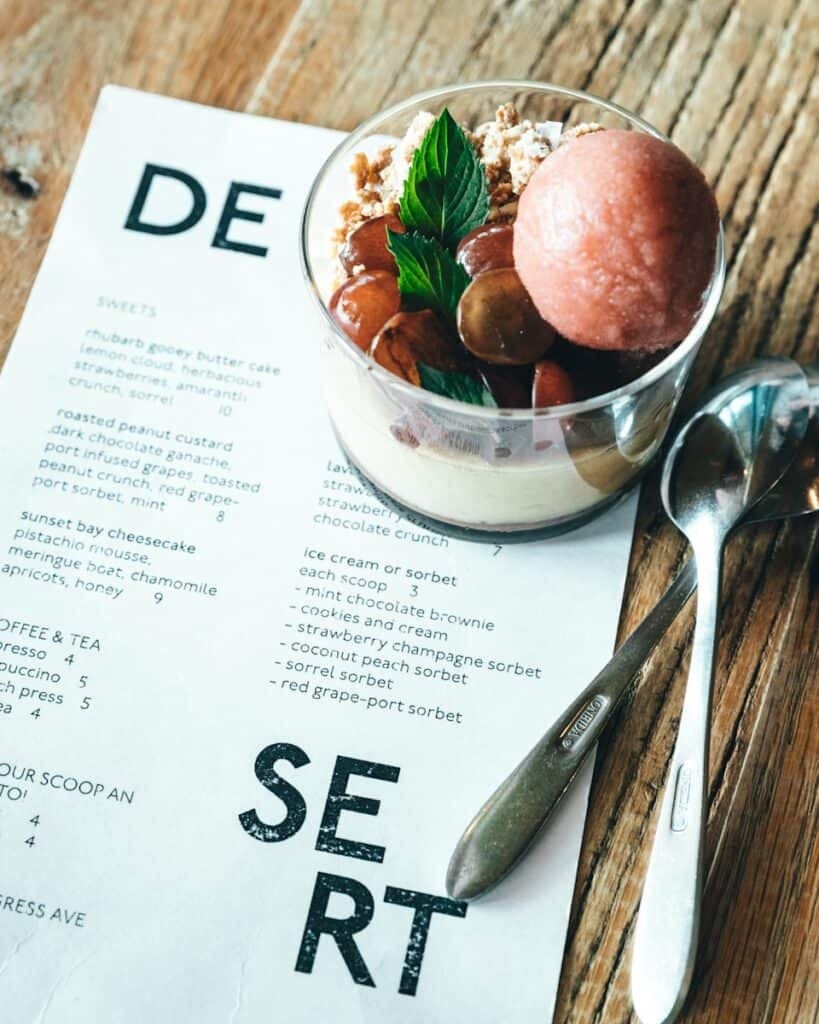Eating low-carb can feel easy at home, but going to a restaurant brings new challenges. Many menus are filled with bread, pasta, and sugary sauces, making it tough to stick to your diet.
But that doesn’t mean you have to avoid eating out! With the right strategies, you can enjoy delicious meals while staying on track.
In this blog post, I’ll help you to pick the right restaurant, choose smart menu options, and make special requests to keep your meal low in carbs. So make sure to keep reading untill the end.
How to Choose the Right Restaurant?

Picking the right place to eat can make a huge difference. Some restaurants offer plenty of low-carb choices, while others have menus packed with carb-heavy dishes.
Researching Restaurant Menus Online
Before heading out, check the menu online using apps like Yelp, OpenTable, or MyFitnessPal, which provide restaurant details, reviews, and nutritional information.
Some of the restaurants apps even allow you to filter menu items by dietary preferences, making it easier to find low-carb options.
Additionally, many restaurant websites now include allergen and ingredient lists, so you can plan your meal in advance without surprises.
Selecting Restaurants with Low-Carb Options
Many eateries specializing in steaks, seafood, and salads usually have good such options. Texas Roadhouse, Outback Steakhouse, and LongHorn Steakhouse are famous chains that serve grilled steaks, salmon, and shrimp suitable for a low-carb diet.
You could enjoy grilled buttered fish along with steamed broccoli at Red Lobster. The Staygreen like Sweetgreen and Chopped Open provides delicious signature salads made with fresh greens, proteins, and a variety of low-carb dressings that can fill you up.
So if you’re at a fast-casual chain, look for bunless burgers, protein bowls, or customizable salads to stay on track. You can often get away with saying it’s Mexican, as long as they let you swap the rice and beans for even more guacamole or veggies.
Burger places that let you order without the bun or Italian restaurants that offer grilled protein dishes without pasta can work, too. Stay away from places where most of their menu is in the following directions: breaded, fried, or served with sugary sauces.
Look for dishes that are instead grilled, roasted, steamed, or sautéed. Baked proteins and vegetables are other healthy, lower-carb options provided at many restaurants.
Ask them to hold the sugary marinades or batter coatings, and instead use olive oil or butter to prepare your meal.
How to Read the Menu Properly?
Reading a menu carefully helps you avoid hidden carbs and find the best options.
Identifying Low-Carb Foods
Look for dishes with grilled meats, leafy greens, and healthy fats like olive oil and butter. Steak, chicken, fish, and eggs are usually good picks.
Salads with real cheese, avocado, and nuts can be filling and low-carb. Ask if they have a lettuce-wrapped burger or a protein plate.
Avoiding High-Carb Traps
Some foods seem low-carb but aren’t. Watch out for sauces and dressings, which often have sugar. Many soups and stews contain hidden flour or starch.
Even grilled meats can be marinated in sugary sauces. Skip the croutons, tortilla chips, and bread baskets. If your dish comes with pasta, rice, or potatoes, ask for a substitute.
Customizing Your Orders
Making small changes to your meal can help you stay within your carb limit.
Asking for Substitutions
Most restaurants allow simple swaps. Instead of fries, ask for steamed broccoli or a side salad. If a sandwich looks good, request it without the bun.
If a dish comes with rice, see if they can replace it with extra veggies or a side of guacamole.
Requesting Modifications to Suit Low-Carb Diet
Don’t be afraid to ask for small changes. Ask for grilled instead of breaded meat. Request no sauce or dressing on the side.
If an ingredient doesn’t work for your diet, see if they can leave it out. Many places are happy to make adjustments.
Tips for Ordering
Simple choices make a big difference in keeping your meal low-carb.
Opting for Grilled or Broiled Proteins
Grilled chicken, steak, fish, and shrimp are usually great picks. Avoid anything breaded or fried, as it adds unnecessary carbs.
Choosing Vegetable-Based Side Dishes
Instead of fries or mashed potatoes, ask for grilled asparagus, sautéed spinach, or a fresh salad. Most restaurants have at least one low-carb veggie option.
Requesting Sauces and Dressings on the Side
Many sauces contain sugar or flour. To control how much you eat, ask for them on the side. That way, you can use just a little instead of letting the kitchen drown your meal in carbs.
Handling Social Situations

Eating out often involves social pressure, but you can stick to your plan without feeling awkward.
If friends push you to have a treat, respond with confidence: ‘That looks great, but I feel better when I stick to low-carb options.’ If someone insists you try a high-carb dish, politely decline by saying, ‘I appreciate it, but I’m really enjoying my meal as it is!’
You can also redirect the conversation by shifting focus to the restaurant’s other offerings: ‘This grilled steak is fantastic—have you tried it before?’
Keeping the focus on your preferences rather than restrictions can help deflect pressure without making it a big deal.
Informing Waitstaff about Dietary Restrictions
Let your server know you’re avoiding carbs. They might suggest good options or help customize your meal. Just keep it simple—there’s no need to explain your entire diet.
Dealing with Peer Pressure
Friends might encourage you to “just have one bite” of something high-carb. Stay firm but polite. If needed, change the subject or joke about how good your meal already is.
Portion Control
Restaurant servings are often huge, so be mindful of how much you eat.
Preventing Overeating
Stick to protein and veggies first, so you fill up on the right foods. Avoid mindless eating, like snacking on chips or bread before your meal arrives.
Sharing Meals or Taking Leftovers
Split an entrée with someone else or ask for a to-go box right away. That way, you won’t be tempted to eat everything in one sitting.
Choosing Low-Carb Meals in Different Cuisines
Low-carb choices exist in every type of cuisine if you know what to look for.
Tips for Low-Carb Options in Various Cuisine Types
- Mexican: Order fajitas without tortillas. Skip rice and beans, but load up on meat, cheese, and guacamole.
- Italian: Choose grilled meats, seafood, or antipasto plates instead of pasta.
- Asian: Go for stir-fried meat and vegetables without rice or sugary sauces.
- American: Ask for a lettuce-wrapped burger or a protein-based salad.
Making Smart Choices in International Restaurants
No matter the cuisine, focus on whole foods—meat, fish, eggs, and vegetables. When dining at Mexican restaurants, ask for lettuce wraps instead of tortillas and opt for grilled proteins with extra avocado.
In Italian establishments, request zucchini noodles or a vegetable medley in place of pasta. Asian cuisine often includes hidden sugars, so order stir-fried dishes without sauce and choose sashimi over sushi rolls.
At Mediterranean spots, focus on grilled kebabs with a side of fresh salad rather than pita or rice. Always ask how dishes are prepared and see if the restaurant can adjust them to align with your low-carb diet.
If in doubt, you can ask how a dish is prepared and request changes if needed.
Some carbs aren’t obvious but can add up fast. Sauces, marinades, and even spice blends can contain sugar.
Soups and gravies often have flour or cornstarch. So feel free to check with your server if something seems questionable.
Avoid glazed meats, breaded toppings, and anything labeled “sweet” or “honey.” When in doubt, ask for a simple preparation. You don’t have to skip treats entirely—just choose wisely.
Many places offer fresh berries with whipped cream or cheese plates. If nothing fits, have a cup of coffee or tea instead.
Also make sure to stick with water, sparkling water, or unsweetened tea. If drinking alcohol, go for dry wine or spirits with club soda instead of sugary cocktails.
What to do if I Slip-Ups?
Well nobody is perfect, and one mistake won’t ruin your progress. If you eat more carbs than planned, just get back on track at your next meal.
One meal won’t undo all your progress. Don’t stress about it. Learn from the experience and make a better choice next time.
Conclusion
And that it! Eating low-carb at restaurants is possible with the right approach. Pick the right place, make smart menu choices, and don’t hesitate to ask for substitutions.
Small changes can keep your meal low in carbs without sacrificing flavor. Want more tips on sticking to your low-carb lifestyle? Stay connected and keep learning!
Every meal is a chance to make a good choice—stick with it, and you’ll see results.